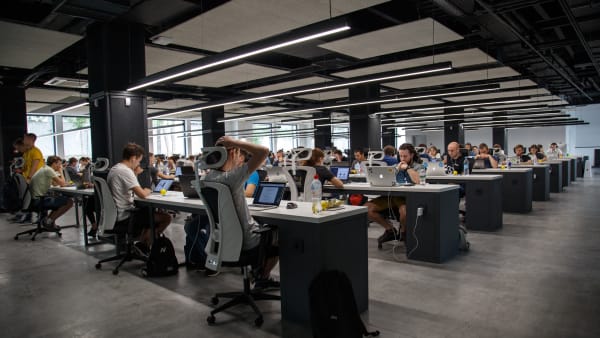
10 HR Models Every HR Team Should Consider Using
January 10, 2023

Human Resource (HR) models are a way to visually represent the HR function in an organization and how HR contributes to the organization's growth and success.
HR models, also known as HR frameworks, depict how each department within an HR function operates, adding value and ensuring the effective management of employees toward an organization's objectives and goals.
Numerous HR models are used by organizations, each focusing on a particular approach, such as motivating employees or a harder approach through performance management. Identifying the most appropriate HR model according to the organization's culture and strategic business aims is essential for the business's success.
This article explores 10 HR models, explaining how they work, and highlighting their strengths and weaknesses.
1. The Standard Causal Model
What is the standard causal model?
The standard causal model describes how improved business performance is achieved when the overall business strategy informs an organization's HR strategy. The model outlines how HR plays a role in ensuring the performance of the organization's people and, in turn, the business's overall financial success.
How does it work?
This HR model states an organization's strategy is the primary influencer of HR strategy.
HR practices are derived from the HR strategy, which then informs the practices of the HR function. The outcomes seen from HR practices influence the internal performance of the workforce and, ultimately, the organization's financial performance:
Business Strategy > HR strategy > HR Practices > HR outcomes > Internal performance > Improved financial performance
Strengths
This model shows how a well-articulated business strategy can inform the success of an organization through its people. Using this HR model also clearly outlines HR's value in contributing to an organization's financial performance.
Weaknesses
A weakness of this model is that it will only be effective if the HR strategy is directly aligned with the business strategy. The model also needs to account for the fact that in some organizations, HR practices may, in fact, contribute to increased internal performance without being influenced by HR outcomes.
2. The David Ulrich HR Model
What is the David Ulrich HR model?
Developed by David Ulrich in 1995, this HR model segments the HR function into four separate areas, each focused on a specific role. Through these four roles, HR as a whole contributes to the organization's productivity rather than being focused on HR processes alone.
How does it work?
The Ulrich model segments the HR function into four roles:
Change Agent
Administrative Expert
Employee Champion
Strategic Partner
By adopting each of these four roles, HR covers both the operational aspect of the function and the people aspect of the function. This approach improves the efficiency of an HR function, especially in larger organizations.
Strengths
The strength of the Ulrich model lies in the way it clarifies the roles of HR as a whole. In doing so, the model describes how HR adds value to an organization's workforce and its role in meeting strategic goals. This model is also beneficial in organizing the HR function of larger organizations, making roles and purposes clear in how HR adds value to the organization.
Weaknesses
The model is beneficial when applied to larger organizations to streamline HR’s roles and purpose. However, given the roles within the model, it may be less applicable to smaller organizations, for example, start-up organizations or SME's which represent over 99% of the UK's businesses.
3. The ASTD Competency Model
What is the ASTD competency model?
The American Society for Training and Development developed the ASTD model in 2004. Updated in 2008/2009 and more recently in 2013, the ASTD model describes competencies that talent development professionals need to develop to succeed in their field.
How does it work?
The ASTD model provides a road map for success as a training and development professional, outlining descriptors that individuals need to demonstrate to achieve success. The model is built on three different layers: foundation level (including core competencies), areas of expertise (AoE), and execution level describing professional-level roles: business partner, learning strategist, project manager, and professional specialist.
Strengths
The strengths of the ASTD model are in the clear articulation of the areas a training development professional needs to develop and incorporate into an HR system to attain success. This model provides a road map that professionals can use to distinguish themselves within an organization and the HR industry.
Weaknesses
The model takes a hierarchical approach to an individual's success and integration into the HR function. This approach may only suit some sizes of organizations or those HR functions where progression or opportunities are more challenging to obtain. This may lead to an organization's loss of talent if individuals cannot develop in the ways outlined in the model.
4. The Warwick Model
What is the Warwick model?
The Warwick model describes how internal and external factors affect the role of the HR function and the context within which HR operates. Focusing on five different factors and building on the Harvard model, the Warwick model explores the impact of these models on an HR function.
How does it work?
The Warwick model considers five elements that influence the way an HR function operates:
- Outer context of an organization: political, laws, and technical regulations that govern the inner workings of the organization;
- Inner context: culture, structure, and leadership of the organization;
- Business strategy: goals and objectives of the organization;
- HRM context: how roles and responsibilities of the function;
- HRM content: the systems and flows such as rewards and employee relations.
Strengths
The model considers the ever-changing factors that influence how an organization operates and how HR must adapt to these changes. For example, the increase in hybrid working offered by 78% of employers in the UK (CIPD) and how this influences the HR function, practices, and processes.
Weaknesses
A weakness of the Warwick model is the lack of appreciation of the external factors and how these have a direct impact on the HR function and the context in which HR works. The outer context, such as employee relations and reward structure, can significantly impact the HR function's work, and this link isn’t considered in the model.
5. The High-Impact HR Operating Model
What is the High-Impact HR operating model?
The High-Impact HR operating model focuses on optimizing the HR function, aligning the function close to the business to attain greater business success. Devised by professional service firm Deloitte, the model incorporates four key areas that drive innovation, technology, and expertise in an HR function.
How does it work?
The model identifies four areas the HR function should focus on to remain agile in a changing business environment. In doing so, the HR function can demonstrate high impact and establish both its value and credibility.
- HR customer: who the internal customers are;
- Capabilities: what are the HR capabilities (digital, capacity to grow);
- Digital information: ensuring access is available;
- Data-driven insights: basing decisions on data.
Strengths
The model outlines the link between a high-impact HR function and how this contributes to business growth and success. The model considers the changing business environment and how technology plays a part in this so that the HR function can leverage it to its advantage.
Weaknesses
The high-impact model is applicable to larger organizations and uses elements that require investment, such as technology and data-driven insights. Investment costs may make these elements challenging to align in a small organization or start-up. The model does provide a valuable blueprint for the future of the HR function when an organization scales up.
6. The Harvard Model of HRM
The Harvard model of HRM was devised in 1994. The model is underpinned by the belief that an organization's objectives and outputs are achieved when a sound HR strategy focuses on employees' well-being. The model places a focus on people rather than outputs first.
What is the Harvard model of HRM?
This model focuses on creating the most optimal working environment for an organization's employees through the policies and procedures developed by the HR function. This 'soft' HR approach considers the broader context of the business, such as business strategy, labor market, and culture. These factors are considered alongside all stakeholders: employees, management, and unions/shareholders, if applicable.
How does it work?
The Harvard model maps out five elements, each with a feedback loop to every aspect: the stakeholder interests and situational factors, both internal and external. The model outlines a workflow between these and policy changes needed in the organization, the outcomes of these (such as increased commitment and cost-effectiveness and how these impact the long-term consequences of an organization.
Strengths
The strengths of the Harvard model lie in recognizing that each of the five elements of the model is affected by and is linked to another element. This ensures that HR is seen from a broader perspective. Also, all stakeholder needs are considered in any changes or updates made by HR.
Weaknesses
The weaknesses of the Harvard model relate to the fact that the model focuses on creating the ideal human resource management function, taking into account many different factors. In reality, is not easy to do. The model also states that if all stakeholder interests are considered, then HR's policies and work will create a perfect working environment which is often not the case.
7. The 5 Ps Model
What is the 5 Ps Model?
The 5Ps model, developed in 1992 by Randal Schuler, focuses on five aspects contributing to organizational success. The model states that when these five elements are aligned, each element, individually and as a whole, drives the strategic implementation of HR processes and procedures, contributing to the business growth.
In 1998, Prior, Whyte and Toombs created another 5P model focused on the Schulers model. It states how strategies determine an organization’s systems, impacting staff and driving performance.
How does it work?
The model considers five factors in the strategic management of people.
Principles: the working culture of the organization;
Processes: day-to-day operations that contribute to the working of an organization;
People: hiring and how people contribute to the organization;
Performance: key performance metrics that measure the performance of the organization and its employees;
Purpose: organizations values and mission.
The model states that each of these factors has a direct impact on the performance of the organization through its people, processes, and the organization's goals, and objectives.
Strengths
The strengths of this model are the recognition that all five elements play a role in influencing each element of the model. If the HR function and the organization are to achieve success, all elements need to be considered. This ensures that HR’s role focuses on both people, processes, and the internal and external environment of the organization.
Weaknesses
A weakness of the 5Ps model is in the time and effort of HR in consistently trying to align all factors in gaining strategic advantage. One factor may have more impact than another depending on the internal or external organizational environment. An appreciation of how these factors may align and input into strategic implementation is needed.
8. The People Value Chain Model
What is the people value chain model?
Created by EY in 2021, the people value chain model takes a long-term focus on how value is created in an organization by four key factors. The model looks at HR in the long term, including how technology influences the role of HR, and how the changing external environment needs to be considered when it comes to the role of HR in adding value to an organization.
How does it work?
The model considers three areas that all HR functions need to consider in today’s changing business environment, working horizontally across all areas rather than in isolation:
People services: listening to employees to share fresh perspectives;
Virtual global business services: management of services across different functions such as IT and legal, enabling functions to work together effectively and efficiently;
Digital people team: new technology and innovation providing data and insights to connect and drive the business forward.
Strengths
A strength of this model is the need for HR practitioners to work together, collaborate and embrace the use of technology. In doing so, mundane tasks can be automated to deliver value financially to an organization’s people, its strategy, and the needs of the organization and society as a whole.
Weaknesses
The model places a focus on technology which requires investment. This type of model may not be applicable to all sizes of organizations due to the level of investment required or the structure of the organization.
9. The HR Value Chain
What is the HR value chain?
The HR value chain model outlines how the outputs of the HR function directly contribute to an organization's objectives and success. Formulated in 1997 on the work of Paauwe and Richardson, the model outlines each of the activities and responsibilities of HR, how these contribute to HR processes and how these affect organizational outcomes such as profit and customer satisfaction.
How does it work?
The model states that all HR activities are segmented according to the roles of the function (efficiency) and the outcome of the function (effectiveness). Roles of the function include training and development, recruitment, and talent management, with outcomes being employee retention and employee satisfaction. The impact on the organization of efficiency and effectiveness leads to meeting organizational objectives.
Strengths
The strengths of this model are in the direct correlation of HR activities, processes, and outcomes on how an organization performs. The model clearly outlines each of HR’s activities and maps out the link between these and the different factors that contribute to the success of an organization.
Weaknesses
The HR value chain needs to take into account the external factors affecting an organization and how these can affect the role of HR when dealing with its employees. Factors such as market environment, which can directly impact areas such as employee retention, are not considered in the model.
10. The 8-box model by Paul Boselie
What is the 8-box model by Paul Boselie?
The 8-box model models what the HR function does while considering how external and internal factors affect it and its outputs. The model shows the interdependencies on factors such as market conditions, skills shortages, competition, and technology and how these change how the function operates, its strategy, and practices.
How does it work?
The model outlines the following:
Configuration (culture and technology of the organization);
HR strategies and practices (divided into four sub-boxes intended and actual HR practices, perceived and actual HR outcomes);
Critical HR goals;
Ultimate business goals.
When developing an HR strategy, the model takes into account the subsequent factors:
External general institutional context (labor market);
External population institutional context (competition, markets, technology);
External general institutional context (values, legislation);
External population institutional context (trade unions).
It depicts the impact these factors have on the work of the HR function and the strategies and practices it devises.
Strengths
The model considers all external factors and parameters that the HR function needs to be aware of, such as legislation, changing work environments, and the impact of trade unions on the decisions they make. This ensures that all factors are considered when devising strategies and procedures to benefit the workforce and the organization.
Weaknesses
The model can appear daunting to HR practitioners in taking into account so many different factors. While being aware of them, it is sometimes difficult to accommodate all contributing factors, which may lead to a delay in decision-making, or an update to existing policies or procedures, causing further disruption within an organization.
How to choose the right HR model for your organization
As shown above, several HR models are available to HR professionals. When choosing a suitable model for your organization, it is essential to consider the values and culture of the organization, the level of investment available, and the organization's working culture.
Understanding the organization's vision, goals, and future objectives enables HR professionals to adopt a model that meets the organization's needs in the future, enabling business growth.
While one HR model in its entirety may not be right for your organization, you must be aware of the existing models and their benefits and weaknesses. This enables you to select the parts of a particular model that work best for your organization, ensuring you are sympathetic to the workforce, aims, and future success of the organization.
Boost your hiring power.
Start using Neuroworx today.
Talk is cheap. We offer a 7-day free trial so you can see our platform for yourselves.
Try for free




